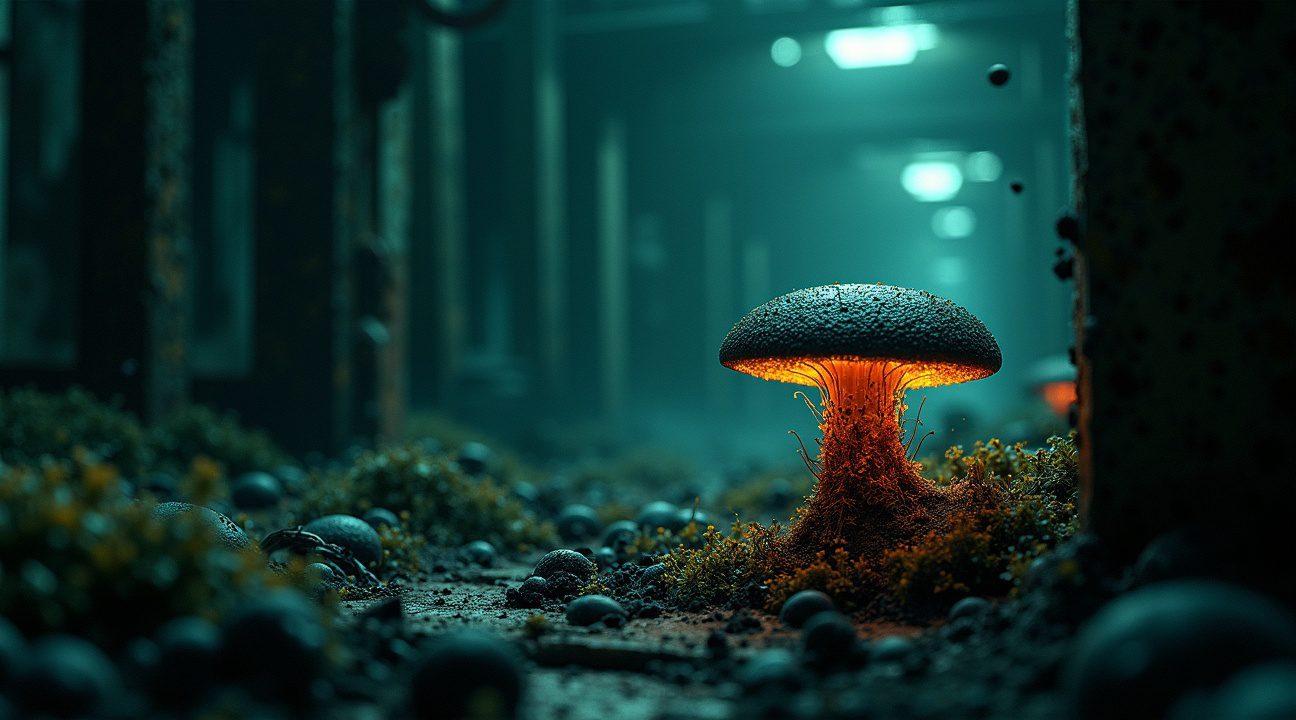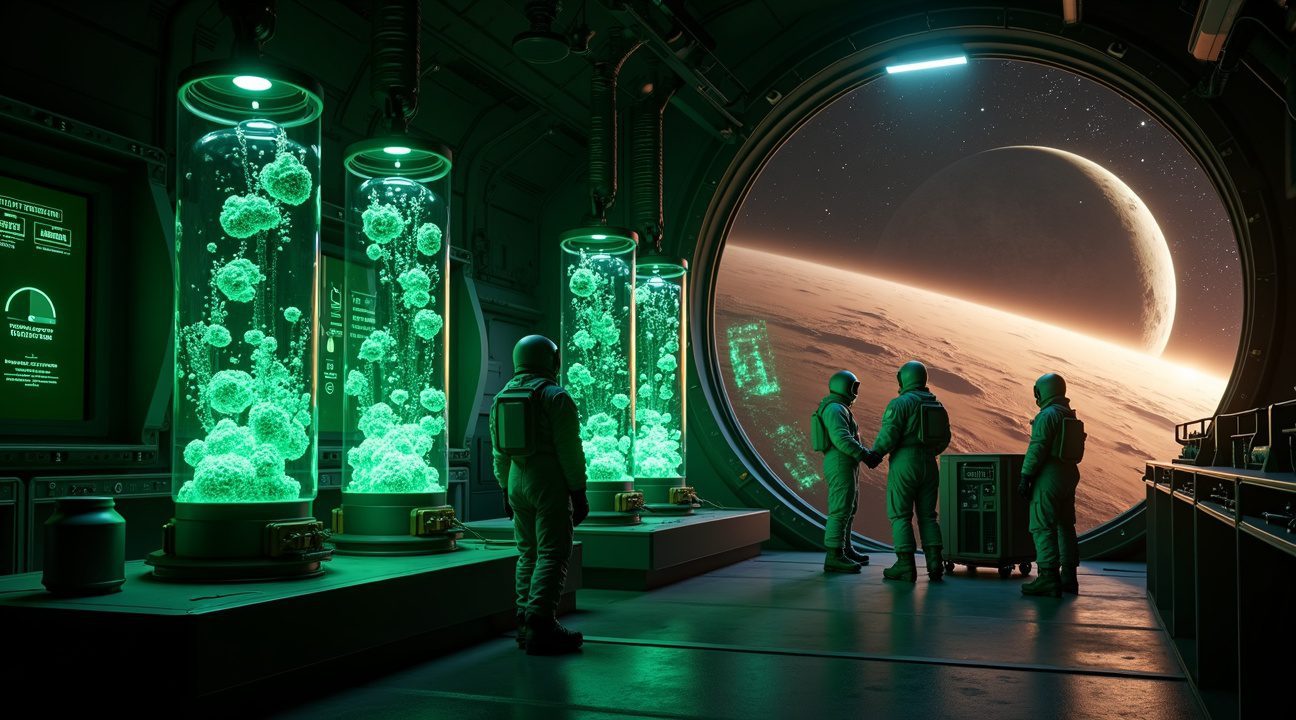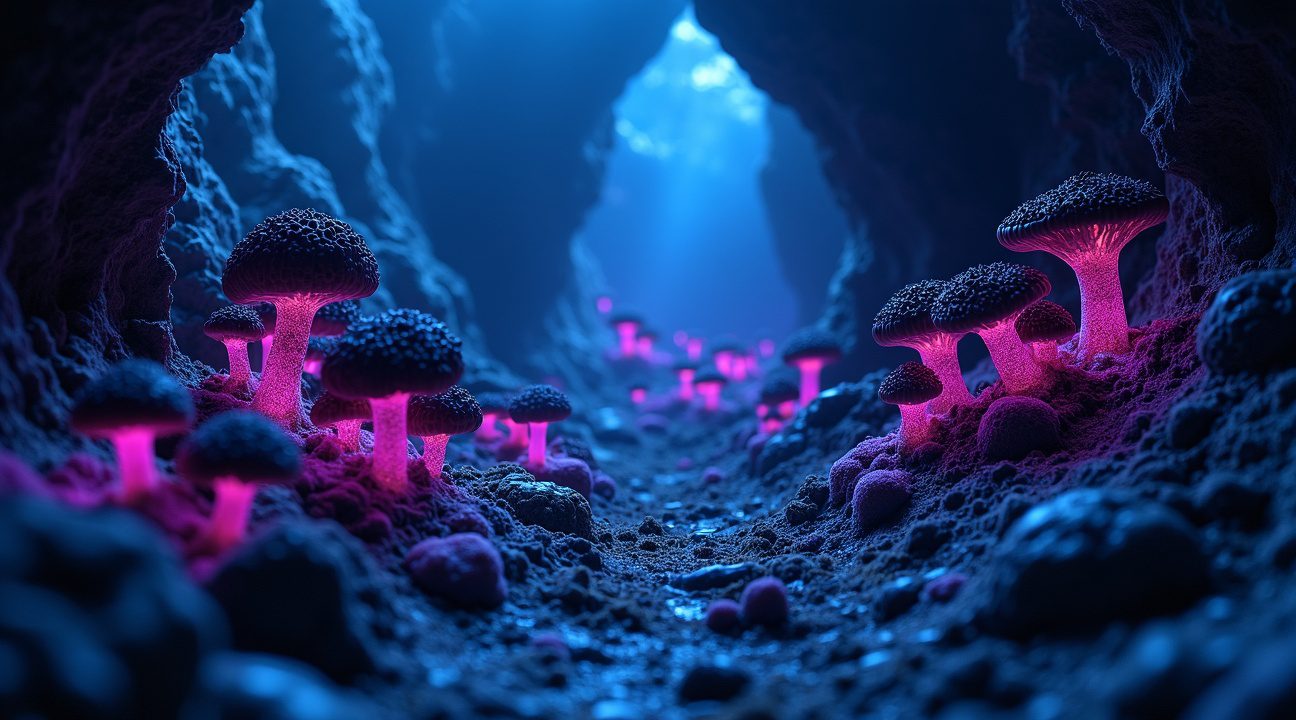Scientists have uncovered jet-black fungi in Chernobyl’s reactor rooms that actively pursue radioactive sources and transform deadly radiation into chemical energy through radiosynthesis.
These extraordinary organisms, including Cryptococcus neoformans and Cladosporium sphaerospermum, utilize melanin pigment to capture gamma radiation in a manner akin to how chlorophyll enables plants to absorb sunlight. This discovery challenges conventional understanding of biological adaptability in extreme environments.
Key Takeaways
- Radiotrophic fungi actively grow toward radiation sources – 66.7% of tested Chernobyl fungal isolates demonstrated statistically significant growth patterns directed at radioactive materials, exhibiting positive radiotropism rather than avoiding dangerous conditions.
- Melanin acts as a biological radiation converter – The dark pigment in these fungi functions like a biological solar panel, increasing energy conversion efficiency by 3-4 times when exposed to radiation and producing increased biomass compared to non-irradiated samples.
- Radiation triggers beneficial genetic and metabolic changes – Exposure upregulates radiation-resistance genes, dramatically increases melanin production, and enhances the fungi’s ability to reduce NADH four times more efficiently than non-radiated melanin.
- Space exploration and nuclear cleanup applications – Scientists propose using these organisms for sustainable energy production on Moon and Mars bases, spacecraft radiation shielding (reducing ambient levels by 2%), and biological cleanup of radioactive waste on Earth.
- Unique energy conversion process unlike any other life form – These fungi represent the only known organisms that thrive because of radiation exposure rather than despite it, using radiosynthesis to convert ionizing radiation into usable chemical energy through melanin-mediated electron transfer.
For more information, read about melanin-mediated radiosynthesis and its promising applications in biotechnology and space exploration.
Jet-Black Fungi Thrive in Chernobyl’s Reactor Rooms, Growing Toward Radioactive Material
I find the behavior of Chernobyl’s fungi absolutely fascinating. After the 1986 nuclear disaster, researchers discovered something extraordinary lurking within the reactor walls: jet-black fungi that weren’t just surviving the intense radiation—they were actively seeking it out.
Three species stood out among these remarkable organisms: Cryptococcus neoformans, Cladosporium sphaerospermum, and Wangiella dermatitidis. Each of these melanin-rich fungi demonstrated an unprecedented ability to flourish on reactor surfaces and contaminated graphite materials. What made their presence even more intriguing was their directional growth pattern, consistently moving closer to radioactive sources rather than away from them.
Radiotropism: The Magnetic Pull of Radiation
Scientists have documented a phenomenon called radiotropism in these Chernobyl inhabitants. This process describes the fungi’s active growth movement directed specifically at ionizing radiation sources. Unlike most life forms that would flee such dangerous conditions, these organisms exhibit positive radiotropism—meaning they grow directly into areas with higher radiation levels.
Controlled laboratory experiments revealed compelling evidence of this behavior. When researchers tested various fungal isolates collected from Chernobyl, they found remarkable consistency in their responses:
- 66.7% of tested Chernobyl fungal isolates demonstrated statistically significant growth patterns directed at radiation sources
- The fungi showed measurably faster growth rates in high-radiation environments compared to clean control areas
- Growth patterns remained consistent across multiple testing scenarios and laboratory conditions
The discovery challenged everything scientists thought they knew about life’s relationship with radiation. Rather than viewing radiation as a destructive force to be avoided, these fungi appeared to treat it as a valuable resource. Their robust growth in contaminated zones suggested they had developed mechanisms to harness radiation’s energy for biological processes.
I’ve observed similar extraordinary adaptations in other extreme environments. Just as some individuals can smell impending rain through atmospheric changes, these fungi seem to detect and respond to radiation gradients in their environment. This sensitivity allows them to navigate directly to energy-rich radioactive materials.
The melanin content in these fungi appears crucial to their success. This dark pigment, which gives them their characteristic jet-black appearance, might function similarly to how chlorophyll works in plants. While plants convert sunlight into usable energy through photosynthesis, these fungi may be converting harmful radiation into biological fuel through what scientists are calling “radiosynthesis.”
Research continues to reveal the sophisticated adaptations these organisms have developed. Their ability to not only tolerate but actively seek radiation sources represents a fundamental shift in understanding how life can adapt to extreme conditions. This discovery has implications far beyond Earth’s contaminated zones, potentially informing our understanding of life’s possibilities in space environments where radiation levels would typically prove lethal to most organisms.
The fungi’s consistent growth patterns and their preference for highly contaminated areas suggest they’ve evolved specific cellular machinery to process radiation. Their success in Chernobyl’s reactor rooms demonstrates that life can find ways to thrive even in environments that seem completely hostile to biological processes.
These remarkable organisms continue to challenge our assumptions about the limits of life on Earth. Their radiotropic behavior represents one of the most striking examples of biological adaptation to extreme conditions ever documented, opening new possibilities for understanding how life might adapt to similarly challenging environments elsewhere in the universe.
How These Fungi Convert Deadly Radiation Into Chemical Energy Like Plants Use Sunlight
I’ve discovered that these remarkable fungi perform what scientists call radiosynthesis, a process that mirrors photosynthesis in plants but uses ionizing radiation instead of sunlight. Just as plants capture solar energy through chlorophyll, these Chernobyl fungi harness deadly radiation through melanin pigment to create chemical energy for growth and survival.
The melanin in these fungi acts as a biological solar panel, but one specifically designed for radiation absorption. When exposed to the intense radioactive environment of Chernobyl—where radiation levels reach up to 500 times normal background levels—melanized fungi actually thrive. Studies show these organisms produce increased biomass and accumulate acetate faster than their non-irradiated counterparts, demonstrating that radiation serves as a genuine energy source rather than just something they tolerate.
The Speed and Efficiency of Radiation Conversion
Research on Cladosporium sphaerospermum reveals the impressive speed at which this energy conversion occurs. I find it fascinating that this fungus can trigger rapid biochemical changes in its melanin within just 20 to 40 minutes of radiation exposure. This quick response suggests an evolved mechanism that efficiently captures and processes radioactive energy.
The efficiency improvements are equally striking. Laboratory tests measuring electron transfer capacity show that irradiated melanin performs 3 to 4 times better than non-irradiated samples. Scientists measure this enhanced capacity through the reduction of NADH and ferricyanide in biochemical assays, providing concrete evidence that radiation genuinely powers these organisms’ metabolic processes.
This discovery challenges our understanding of life’s energy sources and suggests that organisms can adapt to harness even the most hostile forms of energy. While plants have perfected the art of converting light into chemical energy over millions of years, these fungi have apparently developed their own sophisticated system for radiation conversion. The implications extend beyond Chernobyl, potentially offering insights into how life might survive in extremely radioactive environments, including space exploration scenarios where radiation exposure presents significant challenges.
These fungi essentially represent a new form of energy harvesting that could reshape our understanding of extremophile organisms and their survival strategies in environments previously thought uninhabitable.

Melanin Acts as Both Shield and Energy Converter in High-Radiation Environments
I find it fascinating how melanin functions as a dual-purpose biological tool in these radioactive fungi, serving both as protection and as an energy conversion mechanism. This dark pigment shields fungal cells from radiation damage while simultaneously increasing its production when exposed to higher radiation levels. The melanin essentially creates a protective barrier that prevents the harmful effects of ionizing radiation from destroying cellular structures.
Radiation Triggers Genetic and Metabolic Changes
When fungi encounter ionizing radiation, several remarkable adaptations occur that demonstrate nature’s incredible resilience:
- Exposure triggers upregulation of radiation-resistance genes, creating a molecular defense system
- Melanin production increases dramatically in high-radiation environments
- Adaptive evolution occurs in melanized fungi over time, making them better suited for radioactive conditions
- Enhanced sensory capabilities may develop as part of survival mechanisms
Ionizing radiation fundamentally alters melanin’s electronic properties, which scientists can observe through changed electron spin resonance signals. This transformation leads to greatly increased antioxidative activity, essentially turning the pigment into a more powerful protective agent. The most striking discovery involves melanin’s enhanced energy conversion capabilities after radiation exposure.
Radiated melanin reduces NADH four times more efficiently than non-radiated control melanin, suggesting that radiation exposure creates a biological system that can harvest energy from what would typically be a destructive force. This efficiency increase represents a significant metabolic advantage in contaminated environments.
Radiation doesn’t just protect these fungi—it actively promotes their growth and reproduction. Scientists observe both radiostimulation and radioadaptive responses in contaminated strains. Radiation promotes hyphal growth, which allows the fungus to expand its network and access more resources. Spore germination also increases in these radioactive conditions, ensuring successful reproduction despite the harsh environment.
This dual response system demonstrates how life can adapt to extreme conditions that would be lethal to most organisms. The fungi don’t merely survive in Chernobyl’s contaminated zones—they thrive, using radiation as both a shield and an energy source. These discoveries challenge our understanding of how life persists in extreme environments and suggest that similar life-sustaining mechanisms might exist in other harsh conditions throughout the universe.
The implications extend beyond academic curiosity, as understanding these mechanisms could inform biotechnology applications and space exploration strategies where radiation exposure presents significant challenges.
Scientists Propose Using Radiation-Eating Fungi for Space Missions and Nuclear Cleanup
Scientists see enormous potential in harnessing these remarkable organisms as biological energy producers for future space exploration. Radiotrophic fungi could provide chemical energy for Moon and Mars bases using only available cosmic radiation and water — two resources that exist in abundance throughout the solar system. This discovery opens new possibilities for sustainable life support systems in hostile extraterrestrial environments where traditional solar power faces limitations.
Practical Applications Beyond Earth
Research indicates these fungi could serve multiple critical functions on spacecraft and space stations. Studies suggest radiotrophic fungi could reduce ambient radiation levels by approximately 2% aboard spacecraft, potentially offering significant protection for astronaut health during long-duration missions. While this reduction might seem modest, every decrease in radiation exposure proves valuable for human safety in space.
The fungi’s capabilities extend far beyond space applications. Scientists have discovered these organisms can decompose highly radioactive graphite hot particles, making them invaluable for radioactive waste processing on Earth. This characteristic positions them as potential biological tools for:
- Cleaning up nuclear contamination sites
- Managing long-term nuclear waste
- Reducing environmental impacts caused by previous nuclear accidents
Cryptococcus neoformans serves as a primary model organism for researchers studying this phenomenon. Its high melanin content and remarkable adaptability make it ideal for laboratory studies and future applications. The fungus demonstrates consistent performance across various radiation levels, suggesting reliable functionality in diverse environments.
The implications stretch beyond immediate practical applications. Just as researchers have found extraordinary senses in some individuals, these fungi possess abilities that challenge conventional understanding of biological energy systems. Scientists continue exploring how melanin-rich organisms convert gamma radiation into usable energy through processes similar to photosynthesis.
Future space missions could integrate these organisms into closed-loop life support systems, where they simultaneously generate energy and reduce harmful radiation exposure. The fungi require minimal resources beyond radiation and moisture, making them exceptionally practical for resource-constrained space environments. Their ability to thrive in extreme conditions mirrors discoveries of life in unexpected places, much like ancient forests found in massive sinkholes.
Current research focuses on:
- Optimizing fungal strains for specific energy and safety applications
- Understanding the precise biochemical mechanisms behind radiosynthesis
- Enhancing radiation-to-energy conversion efficiency
- Maintaining the natural resilience of these organisms in engineered environments
These developments could revolutionize both space exploration and nuclear waste management, offering biological solutions to some of humanity’s most complex technological challenges.

Why Radiation-Eating Fungi Are Unlike Any Other Life Form on Earth
Radiotrophic fungi represent a completely different category of extremophiles compared to organisms that simply tolerate harsh conditions. Most extremophiles survive despite challenging environments, but these remarkable fungi actually thrive because of radiation exposure. I find this distinction crucial for understanding just how extraordinary these organisms truly are.
How Fungi Transform Deadly Radiation Into Life-Sustaining Energy
The energy conversion process in radiotrophic fungi mirrors photosynthesis in fascinating ways, yet operates through entirely different mechanisms. Plants harness sunlight using chlorophyll to drive photosynthesis, converting carbon dioxide and water into glucose through complex photosystems. Fungi, however, utilize ionizing radiation and melanin to power radiosynthesis, producing biomass and acetate instead of glucose.
Both processes rely on electron transport chains, but fungi achieve this through melanin-mediated electron transfer rather than the photosystem complexes found in plants. This melanin acts as a biological semiconductor, capturing gamma radiation and channeling its energy into cellular processes. The ability to convert such dangerous radiation into usable energy places these fungi in a category all their own among Earth’s life forms.
Potential for Discovery in Extreme Environments Worldwide
Scientists believe similar radiation-feeding mechanisms might exist in other extreme locations across our planet and beyond. Antarctic mountains, with their intense cosmic radiation exposure, could harbor fungi using comparable survival strategies. Space stations, constantly bombarded by radiation, present another intriguing possibility for discovering these unique organisms.
Research into these environments remains limited, but the implications are substantial. If fungi can sense environmental changes and adapt to radiation exposure, they might also exist in locations we haven’t yet considered. Deep ocean trenches, high-altitude locations, and even extraterrestrial environments could potentially support similar life forms.
The discovery of radiotrophic fungi challenges our fundamental understanding of how life can adapt and flourish. These organisms don’t just survive radiation—they’ve evolved to depend on it completely. This dependency makes them unlike any other known life form, opening new possibilities for understanding extremophile biology and potentially revolutionizing our approach to life detection in hostile environments throughout the universe.

Sources:
NASA (2022 COSPAR abstract), National Center for Biotechnology Information (PMC article), Wikipedia (Radiotrophic fungus), Yinova Center (blog post: Healing Power of Mushrooms: What Chernobyl’s Mysterious Black Fungi Reveal), American Society for Microbiology (journal article in Applied and Environmental Microbiology)


